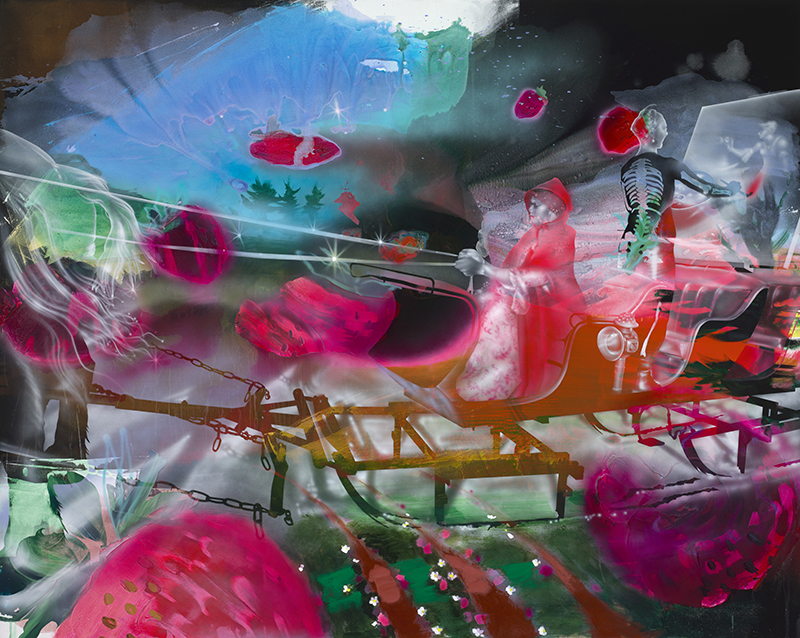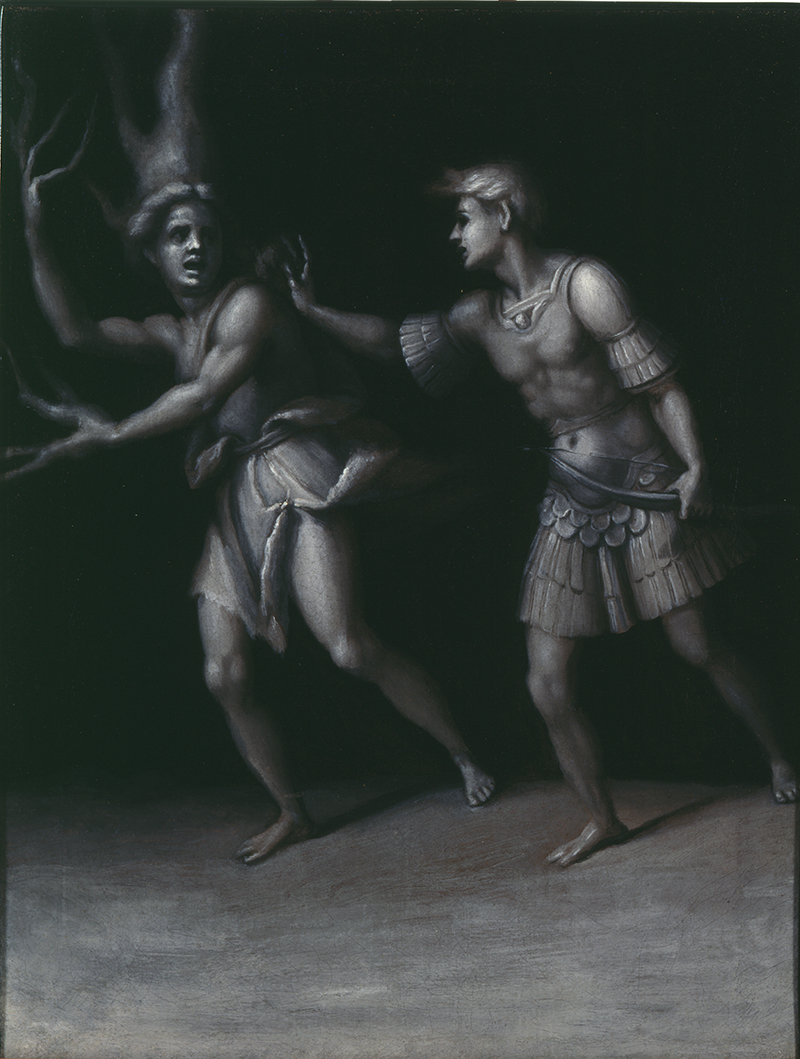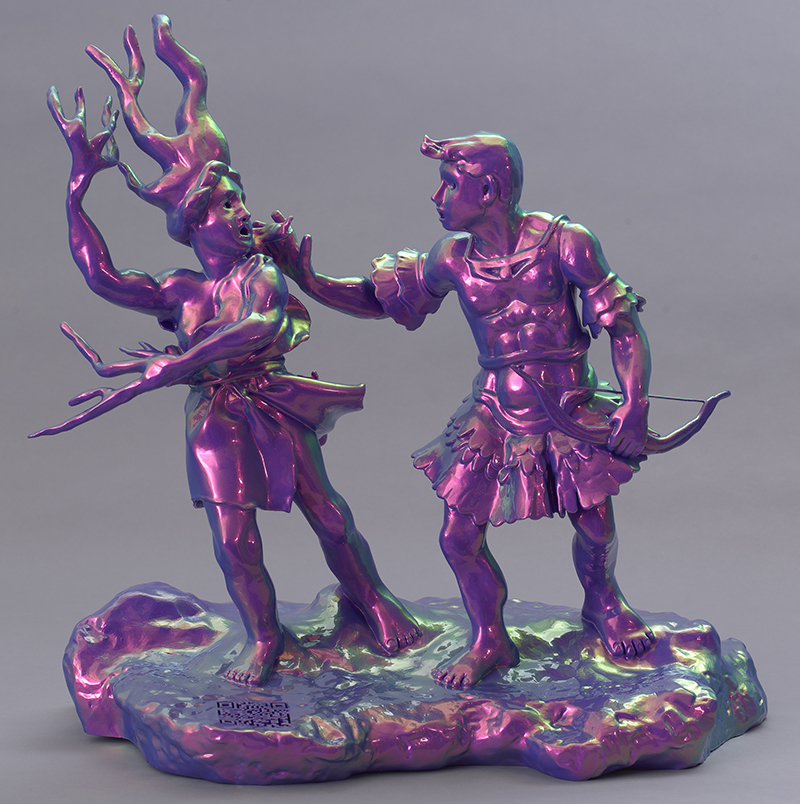"Emilie Stark-Menneg’s Supernatural" opens
By Bowdoin College Museum of Art
Emilie Stark-Menneg, Sleighing, 2023, acrylic on canvas, 80 x100 in. Photo by Luc Demers.
On view until August 20th in the Museum’s Zuckert Seminar Room, Emilie Stark-Menneg’s Supernatural explores the porosity of the boundaries between the natural world and human experience, between fantasy and the everyday, and between life and death. These are slippages explored not only thematically but also through the broad range of mediums engaged by the artist, including intersecting works of painting, three-dimensional photography (anaglyphs), sculpture, and animation.
Inspired by art of the thirteenth to the twenty-first century from the holdings of the Museum and on long-term loan to it through the generosity of the Wyvern Collection, Emilie Stark-Menneg weaves a complex tale of death and regeneration growing out of the myth of Apollo and Daphne. Using as a springboard Pontormo’s 1513 oil on canvas, which captures the god Apollo’s vain pursuit of the nymph Daphne, Stark-Menneg reimagines the tale of frustrated desire as a story of interconnection and mutual transformation leading to rebirth.
 With a beautifully conceptualized installation, illuminated by the lighting designer Austin Shull, Stark-Menneg positions her viewer within an enchanted forest, opening onto clearings that reveal glimpses of the interaction and transformation of Apollo and Daphne. The dark walls of the gallery accentuate the shimmering surfaces of Stark-Menneg’s own artworks as well as those that have inspired her, including works by Pontormo and other masters of early Renaissance and—closer to our own day—pieces by Ana Mendieta, Chris Ofili, and Folkert de Jong. As Stark-Menneg observes of the works to which she responds: “In many instances, the artists attempted risky if not impossible pictorial feats, seeking to create illusionistic space and life-like representations in rare or newly adopted artistic mediums such as mother-of- pearl, minerals, Super 8-mm film, and photorefractive crystals.” In similar form, Stark-Menneg energetically pushes the limits of the materials she uses, creating large paintings, photographic anaglyphs that assume an illusionistic third dimension, and creating sculptures that are in turn enhanced by augmented reality narratives, animated by Elijah Ober.
With a beautifully conceptualized installation, illuminated by the lighting designer Austin Shull, Stark-Menneg positions her viewer within an enchanted forest, opening onto clearings that reveal glimpses of the interaction and transformation of Apollo and Daphne. The dark walls of the gallery accentuate the shimmering surfaces of Stark-Menneg’s own artworks as well as those that have inspired her, including works by Pontormo and other masters of early Renaissance and—closer to our own day—pieces by Ana Mendieta, Chris Ofili, and Folkert de Jong. As Stark-Menneg observes of the works to which she responds: “In many instances, the artists attempted risky if not impossible pictorial feats, seeking to create illusionistic space and life-like representations in rare or newly adopted artistic mediums such as mother-of- pearl, minerals, Super 8-mm film, and photorefractive crystals.” In similar form, Stark-Menneg energetically pushes the limits of the materials she uses, creating large paintings, photographic anaglyphs that assume an illusionistic third dimension, and creating sculptures that are in turn enhanced by augmented reality narratives, animated by Elijah Ober.
 Creating an environment that draws attention to the very construction of illusion, Emilie Stark-Menneg invites the viewer to reflect upon the intersection between the world of the imagination and the world that encompasses us. In seeking to make us aware of the fluidity of perception, Stark-Menneg also reminds her audience of the flexibility of thought itself, inviting us to consider just what magical thinking may throw our own daily experience into new relief.
Creating an environment that draws attention to the very construction of illusion, Emilie Stark-Menneg invites the viewer to reflect upon the intersection between the world of the imagination and the world that encompasses us. In seeking to make us aware of the fluidity of perception, Stark-Menneg also reminds her audience of the flexibility of thought itself, inviting us to consider just what magical thinking may throw our own daily experience into new relief.
Please join us on Thursday, July 20th for a public program with artist Emile Stark-Menneg.
Major support for the exhibition has been provided by the Lowell Innes Fund.
Anne Collins Goodyear
Co-Director
Bowdoin College Museum of Art
Illustration: Apollo and Daphne, 1513, oil on canvas by Pontormo (Jacopo da Carrucci), Italian, 1494–1557. Gift of the Samuel H. Kress Foundation. Bowdoin College Museum of Art.